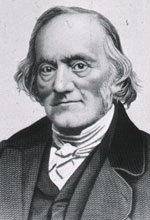Volume 27, Number 12—December 2021
Etymologia
Trichinella spiralis
Trichinella spiralis [tri·kuh·neh′·luh spr·a′·luhs]
Trichinella is derived from the Greek words trichos (hair) and ella (diminutive); spiralis means spiral. In 1835, Richard Owen (1804–1892) (Figure 1) and James Paget (1814–1899) (Figure 2) described a spiral worm (Trichina spiralis)‒lined sandy diaphragm of a cadaver. In 1895, Alcide Raillet (1852–1930) renamed it as Trichinella spiralis because Trichina was attributed to an insect in 1830. In 1859, Rudolf Virchow (1821–1902) described the life cycle. The genus includes many distinct species, several genotypes, and encapsulated and nonencapsulated clades based on the presence/absence of a collagen capsule (Figure 3).
The smallest, viviparous nematode or pig parasite has sylvatic and domestic cycles and causes trichinellosis or trichinosis. Transmission occurs through the consumption of meat infected with pathogenic cysts, encasing larvae (Figure 4). Human-to-human transmission has not been reported.
References
- Campbell WC. History of trichinosis: Paget, Owends and the discovery of Trichinella spiralis. Bull Hist Med. 1979;53:520–52.PubMedGoogle Scholar
- Centers for Disease Control and Prevention. Trichinellosis: general information [cited 2021 May 11]. https://www.cdc.gov/parasites/trichinellosis/gen_info/faqs.html
- Gottstein B, Pozio E, Nöckler K. Epidemiology, diagnosis, treatment, and control of trichinellosis. Clin Microbiol Rev. 2009;22:127–45. DOIPubMedGoogle Scholar
- Zarlenga D, Thompson P, Pozio E. Trichinella species and genotypes. Res Vet Sci. 2020;133:289–96. DOIPubMedGoogle Scholar
Figures
Cite This ArticleRelated Links
Table of Contents – Volume 27, Number 12—December 2021
| EID Search Options |
|---|
|
|
|
|
|
|




Please use the form below to submit correspondence to the authors or contact them at the following address:
Monika Mahajan, Medical Microbiology, Postgraduate Institute of Medical Education and Research, Research Block A, Sector 12, Chandigarh 160012, India
Top